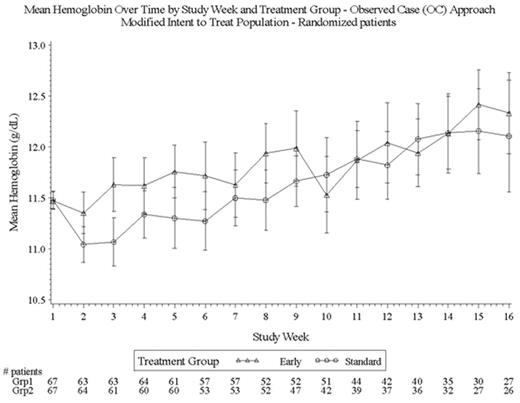Abstract
In the setting of CIA, EPO is effective in maintaining hemoglobin (Hb) levels above the threshold at which packed red blood cell (PRBC) transfusions would be required (usually 8–10 g/dL). This is the first study to evaluate whether Hb levels could be adequately maintained with Q3W EPO initiation treatment. This 16-week open-label randomized study enrolled patients with non-myeloid malignancy, baseline Hb ≥11.0 and ≤12.0 g/dL, and chemotherapy planned for ≥9 weeks. Patients were randomized (1:1) to receive EPO 120,000 U subcutaneously Q3W immediately (early intervention group) or when Hb fell to <11.0 g/dL (standard intervention group). If, at any dosing visit after the 1st EPO dose, Hb decreased to <10.0 g/dL, patients were switched to EPO 40,000 U weekly (QW). Dose was withheld for Hb >13.0 g/dL at any dosing visit; dose was reduced for Hb >12.0 g/dL or Hb increase >1.5 g/dL in a 3-week period (current labeling recommends Hb not to exceed 12 g/dL). Results for the protocol-specified primary efficacy endpoint of Percent Values in Range (PVR; the proportion of weekly Hb levels that were ≥11.0 and ≤13.0 g/dL) were reported previously1. The current abstract presents observed case hematologic profiles for the two interventions. Hb data following a switch to 40,000 U QW were censored. A total of 136 patients were randomized (68 per group). Demographics were similar; mean baseline Hb was 11.47 g/dL in the early intervention group and 11.48 g/dL in the standard intervention group. With the exception of Week 2, when the mean Hb level decreased slightly to 11.35 g/dL, weekly mean Hb levels in the early intervention group remained above the baseline mean and increased gradually through Week 16/end of study (FIGURE). In the standard intervention group (which includes 17 patients who never experienced Hb <11.0 g/dL and never received EPO therapy), mean Hb levels remained below baseline until Week 7. From Week 7 forward, mean Hb levels in the standard intervention group remained at or above the baseline mean and increased gradually through Week 16/end of study. Mean Hb change from baseline to Week 16 was 0.77 g/dL in the early intervention group and 0.59 g/dL in the standard intervention group. On-study PRBC transfusion rates were 13% in the early intervention group and 7% in the standard intervention group. EPO was well tolerated: 6 patients in each group experienced a clinically relevant thrombotic vascular event, and 2 deaths were reported in each group. Early intervention (initiation at Hb ≥11.0 and ≤12.0 g/dL) with EPO 120,000 U Q3W resulted in early gains in mean Hb level relative to standard intervention (initiation at Hb <11.0 g/dL). As increasing numbers of standard intervention patients dropped below 11 g/dL and were started on EPO therapy, mean Hb level recovered and then increased over baseline. Both groups achieved modest increases in mean Hb level over the course of the study period. Initiation treatment with EPO 120,000 U Q3W is effective in maintaining Hb concentrations at a level above that necessitating PRBC transfusions in CIA. 1ASCO 2007 Annual Meeting, Abstract 19564.
Mean Hemoglobin Over Time by Study Week and Treatment Group - Observed Case (OC) Approach Modified Intent to Treatment Population - Randamized patients
Mean Hemoglobin Over Time by Study Week and Treatment Group - Observed Case (OC) Approach Modified Intent to Treatment Population - Randamized patients
Author notes
Disclosure:Employment: V. Moyo, D. Luo, and F. Wilhelm are employees of Ortho Biotech Clinical Affairs, LLC. Consultancy: V. Charu has served as a consultant to Ortho Biotech Clinical Affairs, LLC. Ownership Interests:; V. Charu, V. Moyo, D. Luo, and F. Wilhelm own stock in Johnson & Johnson. Research Funding: V. Charu has received research funding from Ortho Biotech Clinical Affairs, LLC. Honoraria Information: V. Charu has received honoraria from Ortho Biotech Clinical Affairs, LLC. Off Label Use: The Q3W dosing regimen discussed is an off-label use of epoetin alfa.


This feature is available to Subscribers Only
Sign In or Create an Account Close Modal